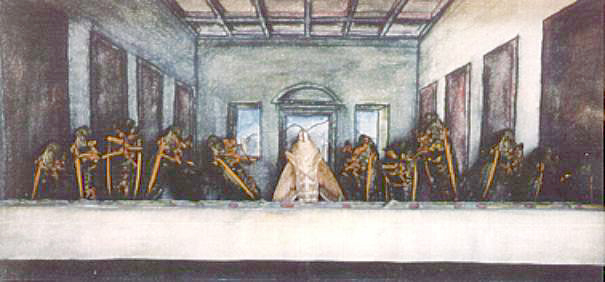Michael Branca - Fine Art
The X Styles

The X Styles
by Elisabeth Gold
Casco Bay Weekly
October 12, 2000
"One thing I've learned," said Portland artist Rachel Katz, "anytime someone tries to put a label on you, you better get as far away from that label as you can. Because you don't want someone else to define you."
So what's Katz, a student at the Maine College of Art, doing exhibiting her work ? installations that depict the constellations in the night sky ? in a new show at Portland's Danforth Gallery called "The Unknown Generation X: Who are We?"
"Generation X is kind of a weird," she said. "No one can really put a label on it. I don't think there's one certain aspect of that generation that they can really say: This is what it is."
That attitude suits the show's organizers just fine. In spite of the exhibit's title, they don't see the show as an attempt to label a generation. Instead, they want to let the audience make its own connections.
"We're not trying to define Generation X," said Helen Rivas, director of the Danforth Gallery. "We just want to provide a platform for Generation Xers to talk about themselves and share it with the rest of the world."
The show features works by 35 artists, from New York City to Newfoundland, between the ages of 19 and 35. Ten of the artists live in Maine.
It doesn't surprise the show's curator, Mark Bessire, director of the Institute of Contemporary Art, that the Gen-X premise provoked strong reactions in the artists. "Virtually everyone I interviewed was angry about the name 'Generation X' regardless of his or her age or station in life," Bessire wrote in a press release. "Most tend to blame this 'name' on the media, about whom they express deep cynicism."
He sees this show as a chance "to get involved with the generation that is positioned to inherit the earth."
Rivas said the show's organizers were inspired by an article about Generation X that appeared in the August 1999 issue of Atlantic Monthly and "dealt largely with the political and social aspect of Generation Xers. The fact that, as a whole, they don't tend to get involved publicly, to join nonprofit organizations and to work together as a unifying force, and in particular, they don't vote a lot. We thought, gosh, next year with the major election coming up, there might be a little bit more attention given to this group of people than normally."
To delve further into these issues, organizers are offering three panel discussions about the generation's relationships with art, politics and technology. In addition, Bessire said four broad themes emerged as he curated the show: the use of everyday items in the art; food and body issues; the questioning of technology and science; and religion and spirituality.
"Oddly enough, as culture has become more global, many artists in this exhibition have turned toward domestic culture and process to address local, national and global cultural politics," Bessire wrote.
"We're not trying to strictly define Generation X art. I personally don't like the term and I almost didn't get involved because of it," said Michael Branca of Portland, who is assisting Bessire with the show and has work in it. "But [it's] been interesting to keep that focus. We want to just have it open and to have all this different work and have the viewers come in and decide what it is that ties all this work together."
Ties may be difficult to find. While Standish artist Michael Angulo's colorful pencil drawing, "Interdependent," shows a collection of wildlife, ranging from parrots to rabbits to cheetahs, all intertwined in different positions, his opinion on the exhibit is considerably less earthy. "I think the reason they're doing it, the whole alien conspiracy, prophecies and all that, [is] there's a real subculture in Gen X which is really interested in that stuff," Angulo said. "It's a lot of kids that are doing soul searching, and they're trying to find out some answers."
Angulo doesn't ordinarily submit his work for shows ("Kind of the Gen X thing, you know, [to] hell with the world"). And he's not satisfied with the choice the organizers made from his drawings. "They took the most benign piece," he said. "It's not a real challenging piece .... The other stuff which I sent them, those are typically the pieces that I do. It's like a ... shamanist, psychedelic look at things, and they didn't seem to, like, appreciate those. I feel like the other pieces are a little more along the Gen-X kind of line. They're a little more substantive."
Katz's installations use lightbulbs inside boxes backed with oil-painted mirrors and hand-scratched constellations to depict the night sky. She said she's trying to reconstruct childhood memories through modern technologies.
"For me, it's a question about nature and about what I expect from nature, kind of what nature is," Katz said. "I kind of believe that there's this idea that's socially created about what nature is. Then there's the actual physical nature, and ... they're two different things. It's based on that feeling of standing beneath the sky and what that made me feel like as a child, and it's sort of blown up as I've grown up. So every time I go outside, I expect to re-create the feeling that's not really re-created."
Which helps explain why there's no simple definition of Gen-X art.
"I don't want to comment on it as a Generation X art show. I don't buy it. It's just a name they had to give us."
Publicity
Home
All artwork copyright Michael P. Branca
|